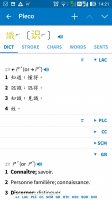naphta
秀才
Hi Mike,
I've been using the LAC dictionary for a while without really paying attention to the variations in prononciation it explains. When a word is pronounced differently in Taiwan or China there's an arrow before the phonetic transcription. It is supposed to indicate where it is pronounced like that, but I find it quite confusing.
The thing is that on the list preview you can actually see what corresponds to 台拼 and what to 陸拼. See my screenshots. I think that having that information on the definition screen as well would be much more clear than just the arrows.
I've been using the LAC dictionary for a while without really paying attention to the variations in prononciation it explains. When a word is pronounced differently in Taiwan or China there's an arrow before the phonetic transcription. It is supposed to indicate where it is pronounced like that, but I find it quite confusing.
The thing is that on the list preview you can actually see what corresponds to 台拼 and what to 陸拼. See my screenshots. I think that having that information on the definition screen as well would be much more clear than just the arrows.


